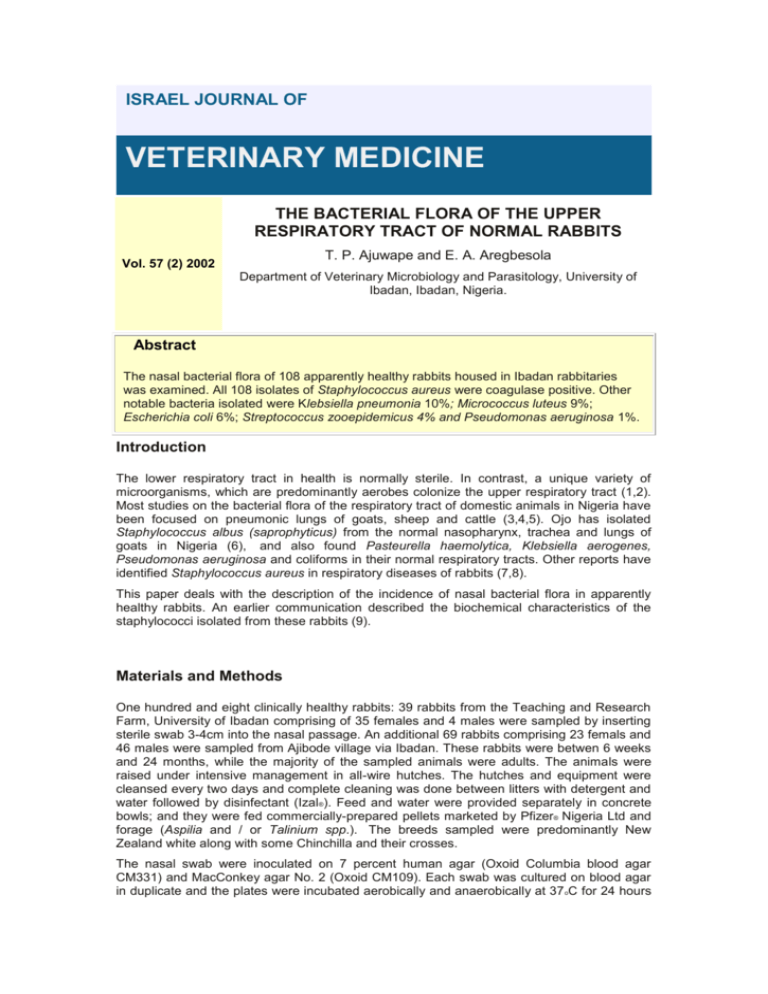the bacterial flora of the upper respiratory tract of normal rabbits
advertisement

ISRAEL JOURNAL OF VETERINARY MEDICINE THE BACTERIAL FLORA OF THE UPPER RESPIRATORY TRACT OF NORMAL RABBITS T. P. Ajuwape and E. A. Aregbesola Vol. 57 (2) 2002 Department of Veterinary Microbiology and Parasitology, University of Ibadan, Ibadan, Nigeria. Abstract The nasal bacterial flora of 108 apparently healthy rabbits housed in Ibadan rabbitaries was examined. All 108 isolates of Staphylococcus aureus were coagulase positive. Other notable bacteria isolated were Klebsiella pneumonia 10%; Micrococcus luteus 9%; Escherichia coli 6%; Streptococcus zooepidemicus 4% and Pseudomonas aeruginosa 1%. Introduction The lower respiratory tract in health is normally sterile. In contrast, a unique variety of microorganisms, which are predominantly aerobes colonize the upper respiratory tract (1,2). Most studies on the bacterial flora of the respiratory tract of domestic animals in Nigeria have been focused on pneumonic lungs of goats, sheep and cattle (3,4,5). Ojo has isolated Staphylococcus albus (saprophyticus) from the normal nasopharynx, trachea and lungs of goats in Nigeria (6), and also found Pasteurella haemolytica, Klebsiella aerogenes, Pseudomonas aeruginosa and coliforms in their normal respiratory tracts. Other reports have identified Staphylococcus aureus in respiratory diseases of rabbits (7,8). This paper deals with the description of the incidence of nasal bacterial flora in apparently healthy rabbits. An earlier communication described the biochemical characteristics of the staphylococci isolated from these rabbits (9). Materials and Methods One hundred and eight clinically healthy rabbits: 39 rabbits from the Teaching and Research Farm, University of Ibadan comprising of 35 females and 4 males were sampled by inserting sterile swab 3-4cm into the nasal passage. An additional 69 rabbits comprising 23 femals and 46 males were sampled from Ajibode village via Ibadan. These rabbits were betwen 6 weeks and 24 months, while the majority of the sampled animals were adults. The animals were raised under intensive management in all-wire hutches. The hutches and equipment were cleansed every two days and complete cleaning was done between litters with detergent and water followed by disinfectant (Izal®). Feed and water were provided separately in concrete bowls; and they were fed commercially-prepared pellets marketed by Pfizer® Nigeria Ltd and forage (Aspilia and / or Talinium spp.). The breeds sampled were predominantly New Zealand white along with some Chinchilla and their crosses. The nasal swab were inoculated on 7 percent human agar (Oxoid Columbia blood agar CM331) and MacConkey agar No. 2 (Oxoid CM109). Each swab was cultured on blood agar in duplicate and the plates were incubated aerobically and anaerobically at 37 oC for 24 hours while the MacConkey agar plates were incubated aerobically only. Mycoplasma culture was not done. Full identification of the pure cultures was carried out according to standard techniques (10). Results The anaerobic incubation of the duplicate blood agar plate did not result in isolation of additional bacteria. All the rabbits tested were carriers of coagulase positive Staphylococcus aureus as previously reported in an earlier communication (9). Other bacteria isolated were Klebsiella pneumoniae 10%, Micrococcus luteus 9%, Escherichia coli 6%, Streptococcus zooepidemicus 4% and Pseudomonas aeruginosa 1%. Interestingly no pasteurellae were found. (Tables 1 and 2). Table 1: Bacteria isolated from upper respiratory tract of healthy rabbits In Ibadan, Nigeria. Location Teaching and Research Farm University of Ibadan Ajibode Farm Bacteria No of Animals sampled Frequency Incidence % Staphylococcus aureus 39 39 100 Klebsiella pneumoniae 39 0 0 Escherichia coli 39 1 2.6 Streptococcus zooepidemicus 39 1 2.6 Pseudomonas aeruginosa 39 0 0 Micrococcus luteus 39 3 7.7 Pasteurella species 39 0 0 Staphylococcus aureus 69 69 100 Klebsiella pneumoniae 69 11 15.9 Escherichia coli 69 5 7.3 Streptococcus zooepidemicus 69 3 4.4 Pseudomonas aeruginosa 69 1 1.5 Micrococcus luteus 69 7 10.5 Pasteurella species 69 0 0 Table 2: Bacteria isolated from upper respiratory tract of healthy rabbits *Bacteria No of Animals samled Frequency Incidence % Staphylococcus aureus 108 108 100 Klebsiella pneumoniae 108 11 10.2 Micrococcus luteus 108 10 9.3 Escherichia coli 108 6 5.6 Streptococcus zooepidemicus 108 4 3.7 Pseudomonas aeruginosa 108 11 0.9 Pasteurella species 108 0 0 * Some bacteria occurred as multiple infections in rabbits + All isolates were coagulase positive. Discussion The bacteria isolated from the clinically healthy nares of rabbits doffer in some cases from those isolated from the nasopharynx of healthy goats (6). In this study they were predominantly aerobes, as reported by others (2, 4). Despite a lack of published information on the nasal bacterial flora of normal rabbits in this part of the world, the 100% incidence of coagulase positive Staphylococcus aureus reported here is similar to unpublished data from Ibadan. In a similar study in goats the predominance of Staphyloccous aureus of 73.7% was recorded (3); while Ojo reported on a 10% incidence of this organism in healthy goats in Nigeria (6). As stated by Ajuwape and Aregbesola (9) the high incidence of these potentially pathogenic coagulase positive staphylococci in rabbits is of public health significance because of the high correlation that exists between coagulase production and pathogenicity (11,12). Furthermore, research findings on the association of staphylococci with disease have shown a zoonotic association with opportunities for reciprocal transmission between man and domestic animals especially when natural barriers are compromised (14, 15). Also there is an observable increase in the incidence of this bacterium against the backdrop of 10% incidence reported by Ojo and 73.7% reported by Obi et al. though in goats vis-a-vis 100% incidence now recorded in rabbits (6,3). Renquist and Soave reported that Staphylococcus aureus of the same phage types were isolated from the nasal cavity of the rabbit and from the nasal cavity of the animal attendants caring for them (7). The incidence of enterobacteriaceae group: Klebsiella pneumoniae (10%) and Escherichia coli (6%) in the clinically healthy nares of rabbit in the absence of clinical enteritis is note worthy. While Klebsiella are commonly found saprophytes in soil and respiratory tract of healthy animals (12). The 6% incidence recorded in this study is higher than that earlier recorded (6) when no Klebsiella were found in the respiratory tracts of healthy goats. This higher incidence may be related to coprophagy (13). The above findings, not surprisingly, suggest that the natural barriers of these rabbits are able to keep the normal flora in check because the bacteria have been incriminated in lung abscesses, chronic pneumonias and emphysema, notably in cattle (5). The reported 4% incidence of Streptococcus zooepidemicus is lower than 10% recorded from healthy goats while the 1% incidence of Pseudomonas aeruginosa in this work is similar to that recorded (6). Micrococcus species are usually commensals and are non-pathogenic (12). It is worthy of note that no pasteurella species was found in the nares, it suggests that they may not be the carriage site of this organism. Acnowledgements We are grateful for the provision of the reagents used for this work by University of Ibadan. Senate Research Grant Code SRG/FVM/93-94/010a. We are also indebted to Mrs. O.O. Orioke of the Department of Veterinary Microbiology and Parasitology, University of Ibadan for technical support. LINKS TO OTHER ARTICLES IN THIS ISSUE References (1) Ross, P.W.: Clinical bacteriology. Churchill Livingstone, Edinburgh, London 1979. (2) Pelczar Jr. M.J. Chan, E.C.S. and Krieg, N.: Microbiology: concepts and applications, McGraw-Hall Inc. New York, 1993. (3) Obi, T.U., Ojo, M.O., Durojaiye, O.A., Kasali, O.B., Akpavie, S. and Opasina, D.B.: Peste des petits ruminants (PPR) in goats in Nigeria: Clinical, microbiological and pathological features. Zbl. Vet. Med. B: 30: 751-761, 1983. (4) Adekeye, J.D.: Studies on aerobic bacteria associated with ovine and caprine pneumonic lungs in Zaria. Nig. Vet. J. 13: 5-8, 1984. (5) Akpavie, S.O. Okoro, H.O., Salam, N.A., Ikheloa J.O.: The pathology of adult bovine lungs in Nigeria. Trop. Vet. 9: 151-161, 1991. (6) Ojo, M.O.: Caprine pneumonia in Nigeria 1 Epidemiology and bacteria flora of normal and diseased respiratory tracts. Trop. Anim. H1th. Prod. 8: 85-89, 1976. (7) Renquist, D. and Soave, O.: Staphylococcal pneumonia in laboratory rabbit: An epidemiologic follow-up study. J. Amer. Vet. Ass. 155: 1221-1223, 1969. (8) Anonymus: The Merck Veterinary Manual 8th edition, Aiello S.E. (ed.) Merck and Co. Inc. N.J. U.S.A. 1998. (9) Ajuwape A.T.P. and Aregbesola, E. A.: Biochemical characterization of staphylococci isolated from rabbits. Israel J. Vet. Med. 56(2): 45-48, 2001. (10) Cowan, S.T.: Cowan and Steele Manual for Identification of Medical Bacteria 2 nd edition, Cambridge University Press London. 1974. (11) Devriese, L.A., Hajek, F., Oeding, P., Meyer S.A. and Schleifer, K.H.: Staphylococcus hyicus (Somplinsky 1953) comb. nov and Staphylococcus hyicus subsp. Chromogenes subsp. nov. Inter. J. Syst. Bact. 28: 482-490, 1978. (12) Ojo, M.O.: Manual of Pathogenic Bacteria. Shaneson C.I. Ltd. Ibadan, Nigeria, 1993. (13) Fielding, D.: Rabbits, In: Coste R. and Smith, A.J. (eds.): The Tropical Agricultural. CTA/Macmillan Education Ltd. London, 1991. (14) Kloos, W.E.: Natural populations of the genus Staphylococcus Ann. Rev. Microbiol. 34:556-592, 1980. (15) Kloos, W.E. and Jorgensen, J.H. Staphylococci. In: Lennethe; E.H., Balows; A., Hausler Jr. W.J. and Shadomy, H. J. (eds): Manual of Clinical Microbiology 4th ed. American Society of Microbio 1.








